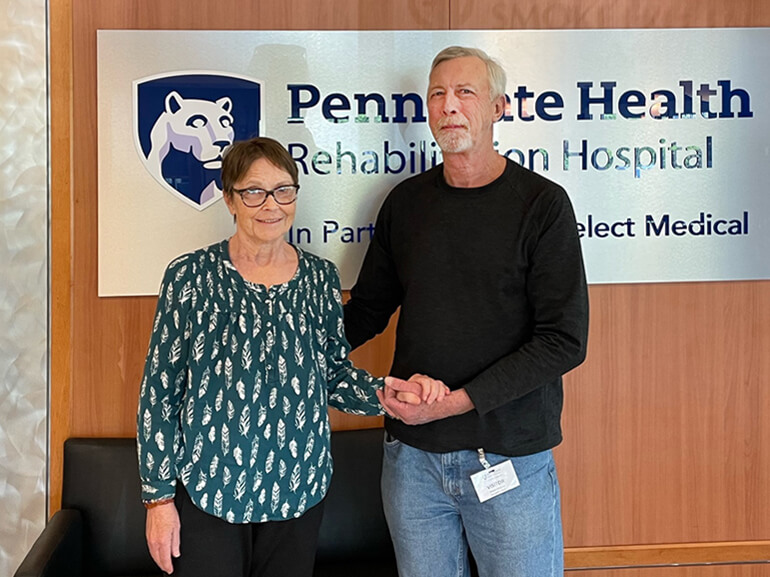Kate's story

Kate Stephens never imagined that retirement would take such an unforeseen twist. While having dinner one night, Kate experienced mild confusion, prompting her to lie down for a rest. Moments later, her husband, Gordon, heard a thud and found her on the floor, unable to speak and with right-sided weakness. Rushed to the hospital, Kate was diagnosed with a stroke on the left side of her brain. Her hospital stay was further complicated by a blood infection and uncontrolled high blood pressure, keeping her in the hospital for two weeks.
In her usual state of health, Kate had been looking forward to exploring new horizons with her husband, Gordon. The couple, who had recently purchased a camper, had dreams of traveling and camping together. Anxious to return to these retirement goals, Kate chose Penn State Health Rehabilitation Hospital for her healing and recovery.
She knew she had an uphill battle ahead with speech and swallowing issues and problems using her right arm, but she was determined to regain her independence and meet her goal of returning home. With Gordon at her side every day and the support of her daughter and grandchildren, Kate began her recovery work.
Physical therapy focused on improving her posture and balance, transitioning her to walking with the assistance of an exoskeleton. The wearable robotic device helps a patient stand and move, relearn their gait and eventually, resume normal walking patterns. By the time she left the hospital two weeks later, Kate had transitioned from needing two people to help her stand, to walking 400 feet with a cane.
Occupational therapy helped Kate regain her strength, coordination and motor control by working on balance and transfer techniques. They had her do sorting and memory exercises to improve her cognition, recall and communication.
Kate also worked on daily living activities with her therapist’s guidance such as bathing, dressing and grooming. They had Kate master one part of task at a time so she wouldn’t get overwhelmed. Gordon sat alongside Kate and participated in her therapies, learning the role he could play in helping Kate on her return home.
Speech therapy helped Kate overcome aphasia, her inability to speak. Therapy sessions included exercises in naming objects, describing pictures, reading and writing. It took time, but these sessions resulted in significant improved Kate’s communication abilities. Throughout her rehabilitation, Kate had several "ah-ha!" moments including saying "I love you" to Gordon. At the conclusion of two weeks of speech therapy, Kate was speaking clearly in short sentences with marked improvement at finding the right words.
Concurrently, the care team worked on Kate’s swallowing difficulties. They had her eat pureed foods and thickened liquids, and she gradually progressed to soft solids and thin regular liquids, with training on safe swallowing strategies. Another milestone was reached when Kate regained movement in her right arm to feed herself.
As Kate reflected on her rehabilitation experience, she employs what she learned in therapy with short statements that get right to the point: "great people," "great care," and "great therapy." She looks forward to returning home and planning an upcoming trip to Iceland.